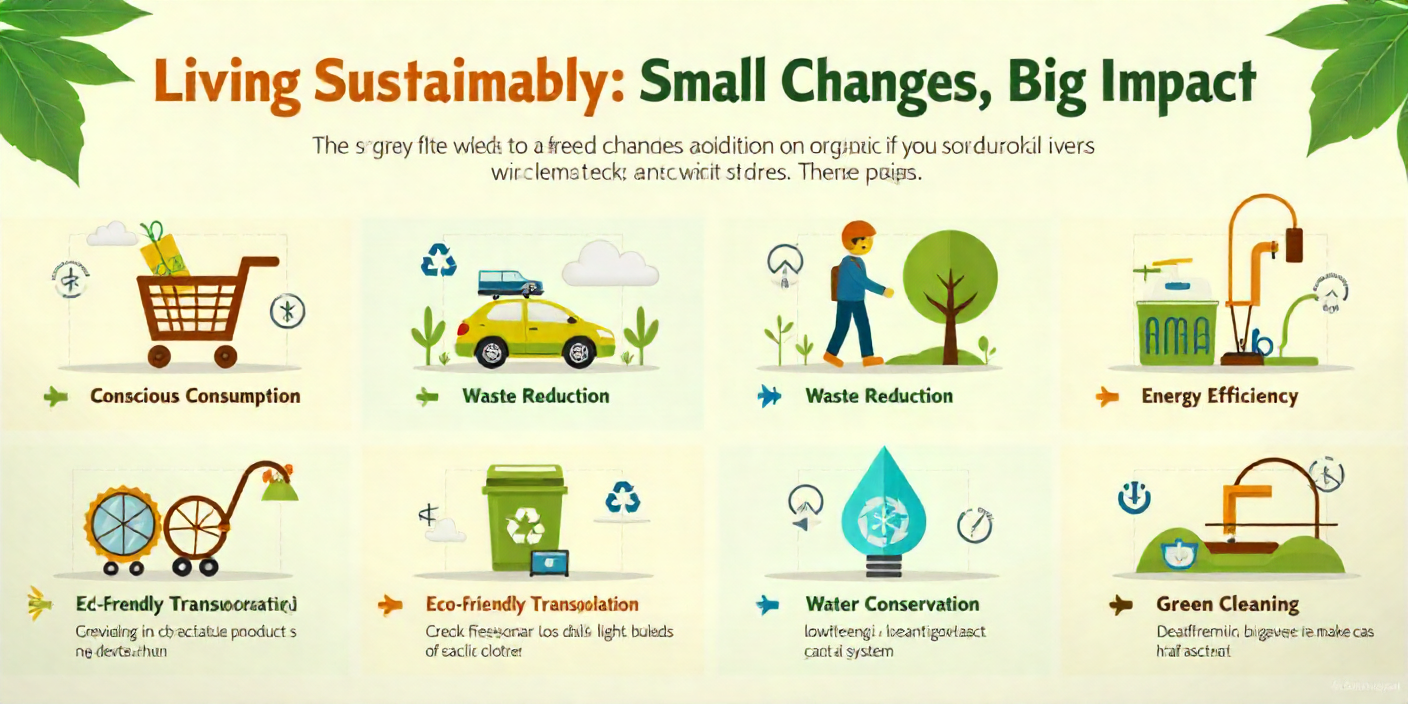
Embracing a Sustainable Lifestyle: Practical Tips for Living More Mindfully
Introduction
In an era where environmental concerns are at the forefront of global conversations, adopting a sustainable lifestyle has become more important than ever. The choices we make every day—whether it’s the food we consume, the products we purchase, or how we manage our energy—have a profound impact on the planet. A sustainable lifestyle is not just about making eco-friendly choices but also about making mindful decisions that contribute to the well-being of both the environment and ourselves.
This article explores the practical aspects of living sustainably. It will provide actionable tips on how to incorporate sustainability into various aspects of daily life, from food and energy consumption to transportation and waste management. By making small, conscious changes, we can collectively contribute to a healthier, more sustainable world.
Understanding Sustainability in Everyday Life
Sustainability is often associated with environmental protection, but it encompasses much more than just reducing our carbon footprint. At its core, a sustainable lifestyle aims to meet our present needs without compromising the ability of future generations to meet theirs. This idea revolves around the three pillars of sustainability: environmental, economic, and social.
-
Environmental Sustainability focuses on conserving natural resources and minimizing pollution and waste.
-
Economic Sustainability aims to create systems that are economically viable and promote long-term growth and stability.
-
Social Sustainability ensures that the benefits of sustainable practices are shared equitably, improving quality of life for all.
By incorporating sustainable practices into daily life, individuals can support all three pillars, creating a more balanced and responsible way of living.
The Power of Conscious Consumption
One of the most effective ways to live sustainably is by becoming more mindful of what we consume. Our purchasing decisions—whether it’s clothing, food, or electronics—have significant environmental and social consequences. By choosing products that are ethically produced, made with sustainable materials, and packaged in eco-friendly ways, we can reduce waste and support businesses that prioritize the environment.
Food Choices:
The food industry is one of the largest contributors to environmental degradation, with factory farming, food waste, and excessive packaging having significant impacts. However, making more sustainable food choices can have a positive effect on the planet.
-
Eat More Plant-Based Foods: Reducing meat consumption, especially beef and lamb, can significantly reduce your carbon footprint. Plant-based foods require fewer resources and produce fewer greenhouse gases.
-
Choose Local and Seasonal Produce: Supporting local farmers reduces the carbon emissions associated with transporting food long distances. Seasonal fruits and vegetables are also fresher and require fewer resources to grow.
-
Minimize Food Waste: A significant amount of food is wasted globally, contributing to both environmental harm and food insecurity. By planning meals and storing food properly, we can reduce waste and save money.
Clothing and Products:
The fashion industry is one of the largest polluters in the world, with fast fashion contributing to waste and environmental degradation. Opting for sustainable clothing choices can make a substantial difference.
-
Buy Less, Choose Wisely: Rather than buying cheap, low-quality items that wear out quickly, invest in durable, high-quality products that last longer.
-
Sustainable Fabrics: Look for clothing made from natural fibers like organic cotton, linen, and hemp, or recycled materials like polyester made from plastic bottles.
-
Second-Hand Shopping: Thrift shopping and buying second-hand items reduces waste and prevents overproduction.
Opportunities:
-
Supporting Ethical Brands: By supporting companies that prioritize ethical sourcing, fair wages, and environmentally friendly practices, consumers can help create a demand for more sustainable products.
-
Waste Reduction: Conscious consumption leads to less waste, reduced landfill contributions, and less pollution.
Challenges:
-
Price Point: Sustainable products can sometimes be more expensive upfront, which can be a barrier for some individuals.
-
Access to Eco-Friendly Options: Not everyone has access to local, organic, or sustainable products depending on their location.
Reducing Waste: Simple Steps to Go Zero Waste
Waste management is one of the most pressing environmental issues today. Landfills are overflowing with plastic, food waste, and packaging that could otherwise be recycled or composted. Transitioning to a zero-waste lifestyle requires rethinking how we use resources, how we dispose of things, and how we can reuse and repurpose materials.
Start with the Basics:
-
Switch to Reusable Products: Single-use plastics, such as water bottles, coffee cups, and shopping bags, are major contributors to waste. Replace them with reusable alternatives made from stainless steel, glass, or bamboo.
-
Composting: Food scraps and yard waste make up a significant portion of landfills. Composting is an easy way to reduce waste while creating nutrient-rich soil for gardens.
-
Recycle Properly: Educate yourself on local recycling programs to ensure you are properly separating and disposing of recyclable materials.
Waste-Free Kitchen:
-
Buy in Bulk: Purchasing food in bulk, without packaging, reduces the amount of plastic and cardboard waste generated. Bring your own containers to the store for even less waste.
-
Plan Your Meals: Meal planning helps reduce food waste by ensuring you only buy what you need and use ingredients before they spoil.
Opportunities:
-
Cost Savings: Reusing items and purchasing in bulk can lead to long-term savings.
-
Environmental Impact: By reducing waste, we conserve natural resources and lessen pollution, contributing to a healthier planet.
Challenges:
-
Lifestyle Change: Transitioning to a zero-waste lifestyle requires commitment and time to change habits.
-
Convenience: Some people may find it difficult to adjust to more sustainable, but less convenient, options.
Sustainable Transportation: Eco-Friendly Alternatives
Transportation is one of the largest sources of carbon emissions worldwide. Shifting from fossil-fuel-powered vehicles to greener alternatives is an essential step in reducing environmental impact.
-
Electric Vehicles (EVs): EVs are an excellent alternative to traditional cars, reducing carbon emissions and decreasing dependence on fossil fuels.
-
Public Transport: Using buses, trains, and trams reduces the number of individual cars on the road, helping reduce traffic congestion and pollution.
-
Cycling and Walking: For short distances, cycling or walking is the most sustainable option, reducing both pollution and personal carbon footprints.
Opportunities:
-
Health Benefits: Walking and cycling not only help the environment but also improve personal health through physical activity.
-
Lower Costs: Public transport and cycling can be more affordable than owning and maintaining a car.
Challenges:
-
Infrastructure Limitations: In some areas, public transport and bike lanes may be underdeveloped, making it harder for individuals to choose sustainable transportation.
-
Initial Investment in EVs: While the long-term savings are significant, the upfront cost of electric vehicles can be prohibitive for some individuals.
Eco-Friendly Home Practices
Your home is one of the most impactful areas where you can make changes to live more sustainably. From reducing energy consumption to switching to more eco-friendly products, the choices you make at home can significantly reduce your environmental footprint.
-
Energy Efficiency: Switch to LED bulbs, install smart thermostats, and use energy-efficient appliances to reduce electricity consumption.
-
Water Conservation: Install low-flow faucets and showerheads to reduce water usage, and be mindful of your water consumption habits.
-
Green Cleaning Products: Avoid toxic chemicals by using environmentally friendly cleaning supplies made from natural ingredients like vinegar, baking soda, and essential oils.
Opportunities:
-
Long-Term Savings: Energy-efficient appliances and water-saving practices reduce utility bills over time.
-
Healthier Environment: Non-toxic cleaning products and sustainable materials contribute to a healthier home environment for you and your family.
Challenges:
-
Upfront Costs: Sustainable home upgrades, such as solar panels or energy-efficient appliances, can require an initial investment.
-
Habit Change: Adjusting everyday routines to incorporate more sustainable practices can take time and effort.
Conclusion
Living sustainably is a powerful way to contribute to a healthier planet, and the good news is that small changes can make a significant difference. By embracing conscious consumption, reducing waste, opting for eco-friendly transportation, and implementing sustainable practices at home, individuals can reduce their environmental footprint and live more harmoniously with the planet.
While the path to sustainability may seem daunting, the rewards are profound—not only in terms of environmental impact but also in personal well-being. A sustainable lifestyle is about making mindful choices, and every step you take towards sustainability is a step toward a better future for all.


